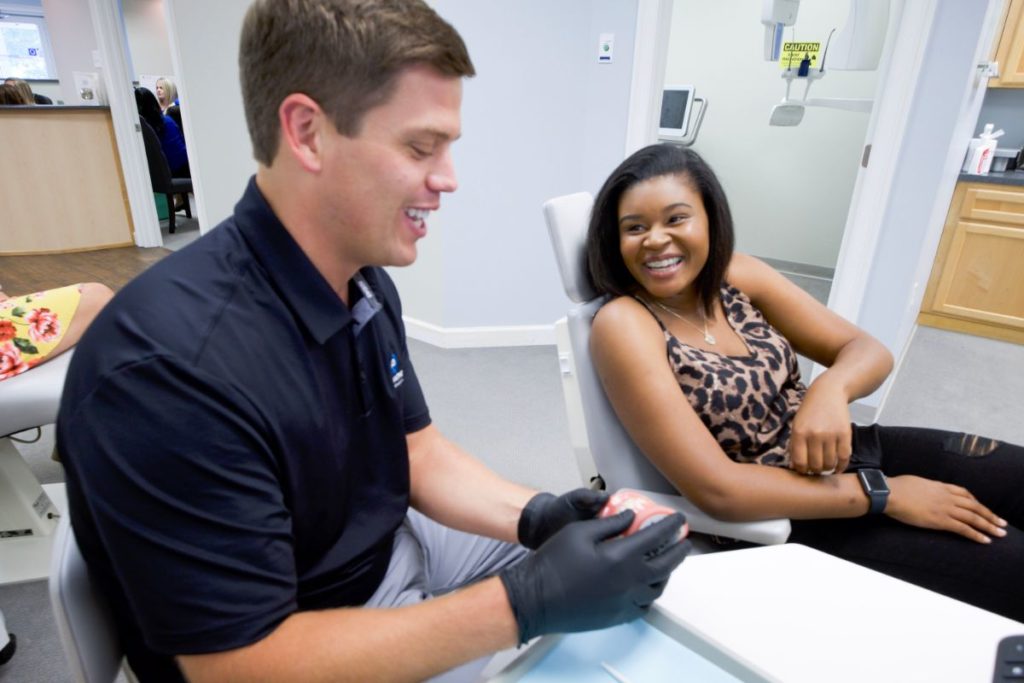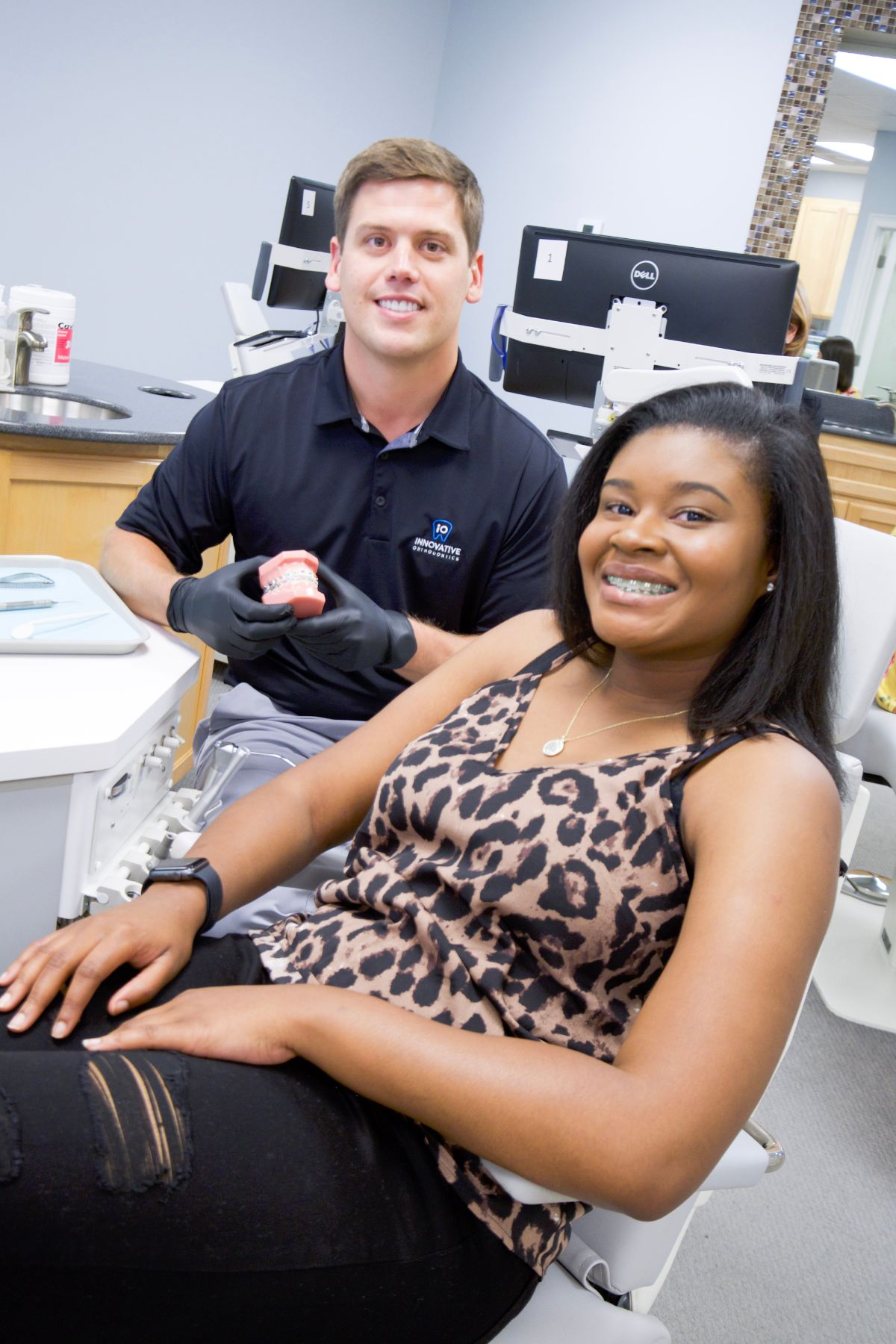Maintaining an excellent dental hygiene routine is an essential part of keeping your smile healthy and happy. It also plays an important role in the success of your orthodontic treatment! Brackets, wires, and other appliances create small spaces that can easily trap food particles. If you aren’t taking good care of your teeth and gums, this can lead to a build-up of plaque and bacteria. These feed on the sugars that enter your mouth and produce acids that can damage your teeth and gums, something that can affect your treatment plan. Brushing up on the basics of orthodontic care can help you avoid these issues!
Here at Innovative Orthodontics, we’ve seen the kind of damage poor oral hygiene can do firsthand, from extending a patient’s total treatment time to halting treatment altogether until the issues can be resolved by a dentist. When you’re more aware of how important oral health is for achieving a straighter smile, it can motivate you to make the most of your dental hygiene! Keep reading below to brush up on the basics of oral care for orthodontic patients.
Tips for braces patients
Once Dr. Waters or Dr. Clayton places your braces, you’ll need to adjust how you brush your teeth and how often you brush them, too. We recommend brushing after every meal and snack, but if you can’t do it right away, be sure to at least rinse your mouth well with water until you’re able to brush.
Brushing 3-4 times a day for at least two minutes each time keeps food particles and plaque from building up in the braces and teeth. While there’s no specific toothbrush we recommend, one with soft bristles is best. That being said, manual toothbrushes can sometimes leave food particles and plaque behind no matter how careful you are! For this reason, we highly encourage you to use an electric toothbrush for the extra power it provides.
Like toothbrushes, no specific toothpaste is required for brushing teeth with braces. Fluoride toothpaste is recommended, however. We also suggest using mouthwash every day to rinse around your brackets and help flush out any food particles that may still be trapped after brushing and flossing. To correctly brush your teeth with braces, refer to these guidelines:
- Hold your toothbrush against the front sides of the teeth, and move it in small circular motions, following the regular curve of the gums and teeth as you go from tooth to tooth.
- Brush each tooth for several seconds, carefully and slowly, making sure all food particles are reached and removed along the gum line, between the braces, and on the surface of each tooth.
- Remember to brush the biting surfaces of the teeth, the backs of the teeth, and behind the molars. And don’t forget to brush the roof of your mouth and tongue before rinsing.
- To properly clean the brackets, angle the brush head against them, and don’t forget to brush thoroughly under the wires as well!
Once you’re finished, carefully inspect your teeth and braces to make sure they’re spotless. Look closely in a well-lighted mirror to see if you’ve missed anything. This is also a great time to check for any loose or broken brackets! If you find a problem, let us know and your orthodontist will advise you on whether or not it needs to be checked out or repaired.
Flossing with braces
Flossing effectively can take practice at the best of times, but it’s really important to do it every night before bed when wearing braces. Even if it seems like you’ve brushed away every bit of food, braces can easily trap particles in places that are hard to see and reach.
Fortunately, there are products available that make this process much easier! Floss threaders are a great example. This reusable tool has a stiff end that allows you to easily floss between the brackets and under the archwire. To correctly floss with braces, give these tips a shot:
- Slide a piece of floss about 18 inches long under the wire, above the space between the two teeth. Insert the floss halfway through, and then hold both ends of the floss. Carefully slide the floss up and down a few times between the teeth. When the tooth is clean, you’ll be able to hear a slight squeaking sound.
- Floss the gum line with the floss in the shape of a “C,” and below the gum line with a soft up and down motion. Be careful not to apply too much pressure when flossing around the archwire.
- Gently remove the floss, thread it under the next wire, and repeat the steps above.
The flossing process may take up to 20 minutes in the beginning, but your speed will increase with practice so don’t give up! It will become second nature in no time and your teeth will thank you for it.

Tips for Invisalign patients
Because Invisalign aligners are designed to be removed before you eat, drink anything other than water, and brush your teeth, oral hygiene is much easier to manage! There are some basic guidelines to follow to ensure your teeth and aligners stay in good shape, however. The first step is to always wash your hands with soap and water for at least 20 seconds before putting your aligner in. Pay careful attention to your fingernails and fingertips since these come into the closest contact with your mouth and aligners.
You’ll need to care for your aligners when they’re out of your mouth, too. It can be tempting to toss them onto the nearest surface when you remove them, but you should always place your aligners in a sealed container when you’re not wearing them. You can also leave them to soak in a cleaning solution. This protects them from germs and prevents you from accidentally throwing them away (which happens more often than you may think!)
Once you’re done eating or your teeth are brushed and flossed, wash your hands again and rinse your aligner well before putting it back in your mouth. Remember that aligners must be worn for 20-22 hours every day throughout the treatment process and switched out for the next in the series every 1-2 weeks as directed by Dr. Waters or Dr. Clayton. When you stick to these guidelines, your Invisalign aligners can work just as well as braces, leaving you with a healthy smile that feels good and looks great!

Take oral care to the next level with Innovative Orthodontics
Giving your smile the care it deserves is one of the easiest ways to ensure a successful orthodontic journey. Brushing up on the basics of orthodontic care ensures that you’ll be doing your part to achieve a healthy mouth while we work on straightening your teeth!
If you have any questions or concerns about your orthodontic care, our expert team is happy to walk you through them anytime. Want to learn more about how to be proactive with your oral health? Contact our Savannah, Rincon, or Pooler office today to schedule a FREE consultation or follow-up appointment with our team of doctors!

